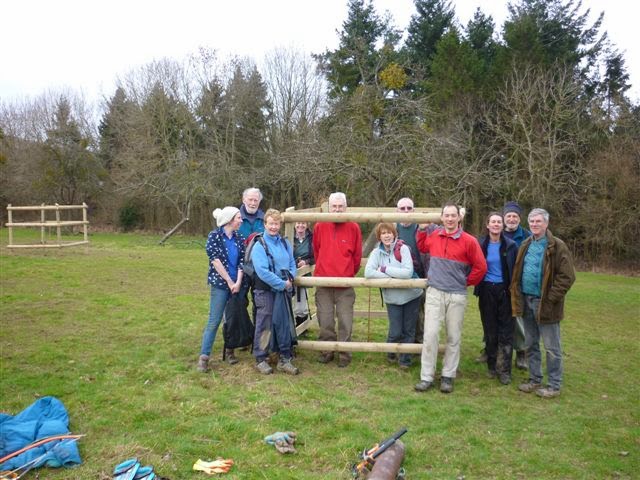Staunton Meend
Wye Valley AONB Volunteers turned out in force on Thursday
28th November 2013 for a day of birch management at Staunton Meend,
a 51 acre area of common land which is being restored to lowland heath. Over
the last few centuries local inhabitants would have exercised their right to
graze, gather firewood and game hunt.
Since these practices have fallen into decline the common land has
become colonised with bracken, bramble and silver birch saplings. Our task was
to remove as many silver birch as we could in the daylight hours given. Luckily there were new recruits to swell our
numbers, Sally and Richard.
Before we tackled this mountain of a task (for the birch
saplings appeared to stretch as far as the eye could see!) John Flynn, leader
of Staunton Meend restoration group, explained to us about the history of the
Meend and previous work undertaken in the restoration work which he has led.
The term 'Meend' is probably derived from the Old English Maene meaning 'held
in common'. In the past restoration work
has involved bracken clearance, dry stone wall building and heather planting, a
key species in the re-generation of the original heathland.
As we eyed the sea of birch saplings, happily thriving
amongst the brown bracken, somebody asked why we were pulling them up, rather
than encouraging the native tree species to flourish. I thought this was a good question. It was explained carefully that lowland
heathland is a priority for nature conservation because it is a rare and
threatened habitat. It has declined greatly in extent during the last two
centuries – in England it is estimated that only one sixth of the heathland
present in 1800 remains – and it still faces major pressures (JNCC 2013).
The habitat is also home to numerous highly sensitive plants and
animals ie reptiles (adders), birds such
as the nightjar. Many scarce and threatened invertebrates and plants are found
on lowland heathland too. So the UK has a special obligation to conserve this
habitat, given that it supports about 20% of the lowland heath in Europe and it
is therefore a priority habitat under the UK biodiversity action plan.
We set to work. The
birch came in a range of sizes, from a pull-able 20cm to hefty trees requiring
tree saws and lumbering. The common height was a meter, probably just a few
years old yet the roots were tenacious and required two of us to extract them,
one to dig whilst the other pulled. We were encouraged by the sight of small
heather plants surviving amongst the trees and bracken encroachment. There were
also gorse and bilberry plants too, all key plants of a thriving heathland.
Whilst we worked there were other animals at work in the
restoration project too, Exmoor ponies who are hardy enough to graze the
developing grassland throughout the year, helping to trample the bracken as
they search for grass. Our labours were rewarded by extensive views from our
vantage point of 250m above sea level of the Autumn colours over the Wye
Valley, south towards the Severn estuary.
Over lunch our task master Sarah told us about a new AONB project which
has attracted lottery funding whilst we munched our sandwiches, a project
developed to enable people living with dementia, their carers of family
and professional, to reconnect with the landscape.
All good work and we left for home with tired limbs,
but happy after a friendly and rewarding atmosphere to work
in. Next
visit, Howle Hill in December.
Sarah also plans to have a day where we can get together and discuss our
views on volunteering work in the AONB.
This is my second day working with the AONB and I love being outside, in
beautiful countryside, trying to achieve something worthwhile. I took some of the saplings home and next
day, planted them in our wood near Usk and they nestle amongst the ash
saplings. Which has most chance of
survival?
Gill Stott























